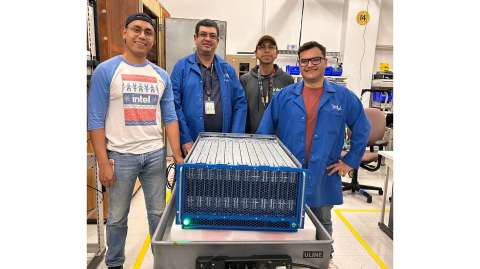Hala Point, the largest neuromorphic computer system in the world, has been officially unveiled by Intel. The computer, which was first used at Sandia National Laboratories in New Mexico, processes information in a manner similar to that of the human brain[1].
Large AI models of today have scaled beyond a trillion parameters, the New York Times stated that AI would someday use as much electricity as the entire nation[2]. These trends show how AI needs to be approached fundamentally differently, and at Intel, we’re investigating a highly effective method dubbed neuromorphic In contrast to today’s AI systems, computing brains require relatively little energy and can handle complicated issues while learning in real time. This is because they rely on sparse and flexible networks of neurons, which compute only when and where it is necessary to achieve higher efficiency and faster response times.

In order to scale up these benefits, we invented Hala point. These brain-inspired networks are currently deployed in Intel’s most recent neuromorphic research chip, Lei 2, in labs across the world. Lui has exhibited orders of magnitude gains and power performance over standard computers. More than 1,000 Lui 2 chips and a billion spiking computes an equivalent of 20,000 tops in a research system.
Research utilizing Hala Point could result in advancements in a wide range of future application domains, from large language models and AI agents capable of continuous learning to logistics and Smart City infrastructure management to scientific and engineering problem solving. That’s 20 quadrillion operations per second.
The next stage in developing neuromorphic computing for more environmentally friendly AI is called Hala Point. Visit Intel.com to find out more about neuromorphic computing. neuromorphic
In a monumental leap forward for artificial intelligence (AI) and computational neuroscience, Intel has unveiled the world’s largest neuromorphic computer, heralding a new era in cognitive computing. This remarkable achievement promises to reshape the landscape of AI research and development, drawing inspiration from the intricate workings of the human brain.
Neuromorphic computing, a field that seeks to emulate the brain’s neural networks in silicon, has long been pursued as a means to unlock unprecedented levels of efficiency and flexibility in AI systems. Intel’s latest creation, aptly dubbed the “neuromorphic beast,” stands as a testament to the company’s unwavering commitment to pushing the boundaries of technological innovation.
At its core, the neuromorphic computer harnesses a vast network of interconnected artificial neurons, enabling it to process information in a manner akin to the human brain. This parallel processing architecture facilitates complex cognitive tasks such as pattern recognition, learning, and decision-making with remarkable speed and efficiency.
The implications of Intel’s achievement are far-reaching. By bridging the gap between biological and artificial intelligence, the neuromorphic computer holds the potential to revolutionize diverse fields, including healthcare, robotics, and autonomous systems. Imagine medical diagnostics powered by AI that can interpret imaging data with the same nuance and accuracy as a seasoned radiologist, or robotic assistants capable of learning and adapting to dynamic environments in real-time.
However, alongside the awe-inspiring potential of Intel’s neuromorphic marvel, ethical considerations loom large. As AI systems grow increasingly sophisticated, questions surrounding autonomy, accountability, and privacy come to the fore. Critics warn of the potential pitfalls of ceding decision-making authority to AI entities that mimic human cognition without the ethical framework inherent to human judgment.
Moreover, the sheer scale and complexity of Intel’s neuromorphic computer raise concerns about its environmental footprint and energy consumption. As society grapples with the urgent need to mitigate the impacts of climate change, the sustainability of burgeoning AI technologies must not be overlooked.
In conclusion, Intel’s unveiling of the world’s largest neuromorphic computer marks a significant milestone in the ongoing quest to unlock the full potential of artificial intelligence. Whether viewed as a technological marvel, a harbinger of ethical dilemmas, or both, one thing remains clear: the era of brain-inspired computing has arrived, and its implications are profound.